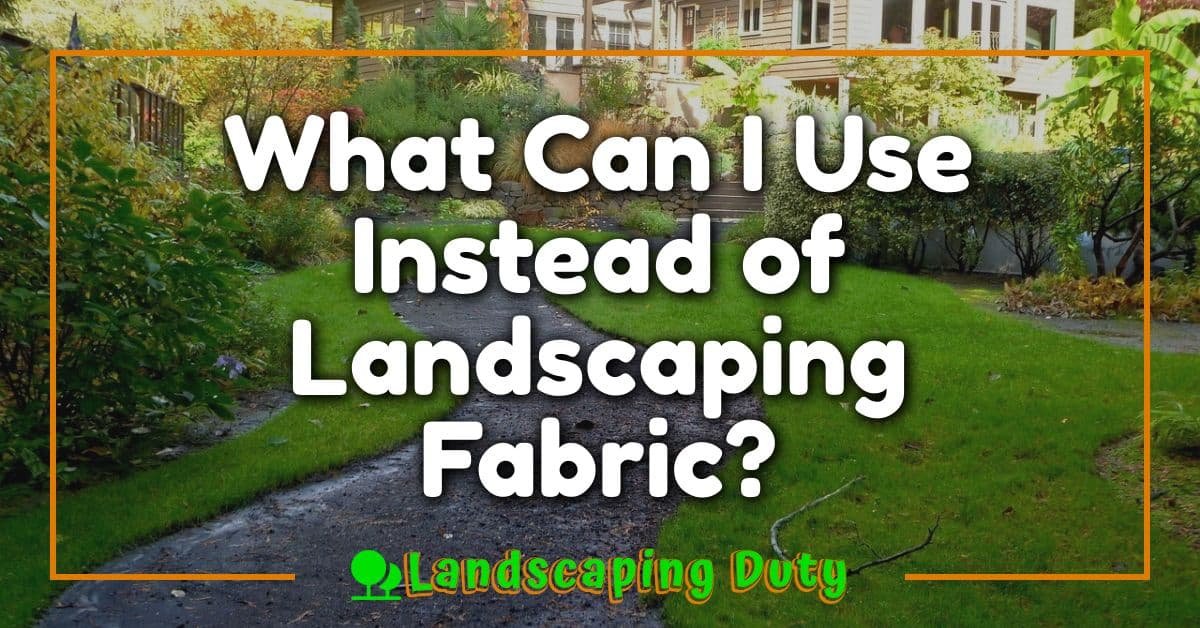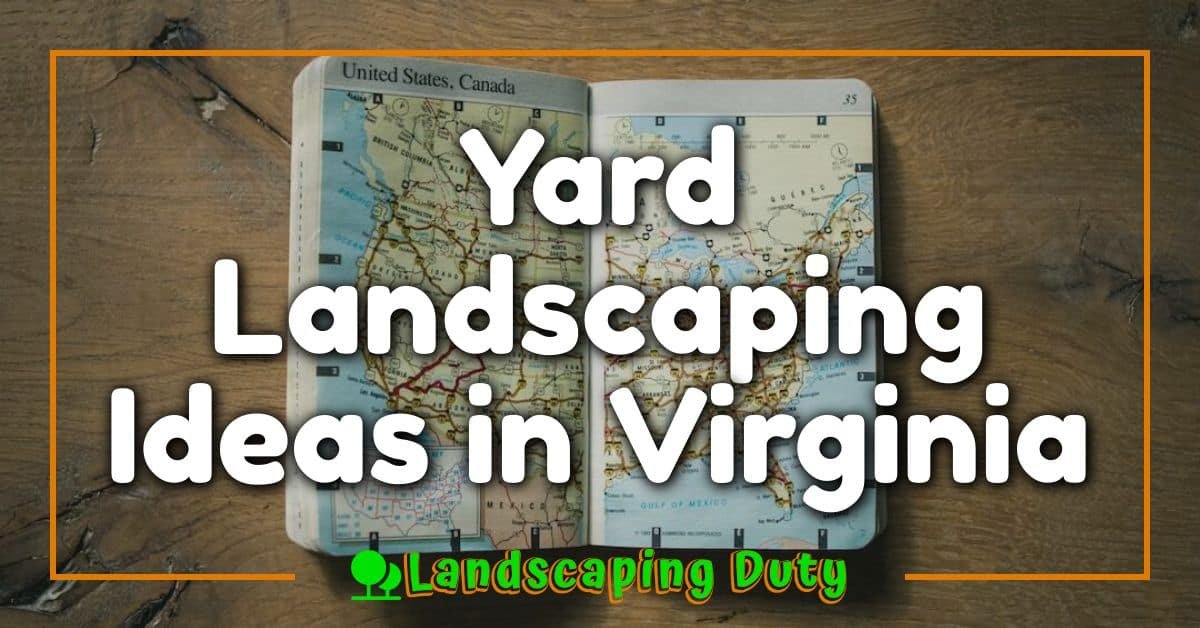So, you’re ready to jump into your landscaping project, but you’ve hit a snag. You don’t want to use traditional landscaping fabric. What’s a green thumb like yourself to do? Well, don’t worry! There are plenty of alternatives out there that can serve the same purpose as landscaping fabric without all the fuss.

Newspaper and cardboard are two popular options for those who’d rather steer clear from classic landscape fabric. They’re eco-friendly, easy to work with, and you probably have them lying around your house already! Another choice could be organic mulches such as straw or wood chips which also help enrich your soil as they decompose over time.
Remember though, it’s not just about finding an alternative. It’s about finding the right fit for YOUR garden. So let’s dig in and explore these options further so you can make an informed decision on what works best for your outdoor space.
Understanding the Purpose of Landscaping Fabric
Let’s dive right into it, shall we? Many folks ask, “Why do I even need landscaping fabric?” Now, you might notice that this wondrous material is a staple in many gardens and landscapes. It’s not just for show! The primary purpose of landscaping fabric is to serve as a barrier. It plays an essential role in controlling weeds that can otherwise take over your beautiful garden.
You know how it goes – one moment, your landscape looks like a scene from a fairytale book; the next, it’s overrun with unwanted weeds! That’s where landscaping fabric comes into play. When properly installed, it blocks sunlight from reaching the soil below and therefore prevents weed growth.
Say goodbye to those pesky intruders! But remember: this fabric isn’t all about control; it also promotes healthy plant growth. By preventing excess water evaporation from the soil surface, landscaping fabric helps maintain ideal moisture levels for your plants’ roots.
Additionally, using landscape fabric has another surprising benefit – erosion prevention. During heavy rains or strong winds (we’ve all been there), topsoil layers can easily get washed or blown away. This won’t happen when you have landscaping fabric holding everything together!
Summing up, while many see landscape fabrics as mere accessories in gardening projects – they are more like unsung heroes! They keep weeds at bay while promoting healthier plant growth AND help safeguard against soil erosion.
Common Issues with Using Landscaping Fabric
So you’ve decided to give your garden a facelift and someone suggests using landscaping fabric. It might seem like the perfect solution, but hold on! There are a few issues you may run into when using this popular gardening tool. Let’s dive right in and discuss some common problems associated with landscaping fabric.
First off, it’s not exactly Mother Nature’s best friend. Over time, as the fabric breaks down, it releases microplastics into your soil. These tiny particles could potentially harm beneficial insects and worms living in your garden ecosystem. There’s also a chance they could make their way into nearby bodies of water, contributing to broader environmental pollution.
Secondly, weeds can still sneak through! Despite being marketed as weed preventative, persistent weeds have been known to break through or grow around the edges of landscaping fabric. Weeds with deep roots can be particularly stubborn, pushing their way up through small tears or seams in the material.
Then there’s the moisture issue. While it’s true that landscape fabrics allow some water to seep through to your plants’ roots, they often don’t let enough moisture pass for optimal plant health. This is especially problematic during hot summers when plants need extra hydration.
Last but certainly not least is nutrient blockage. Sure, landscape fabrics help keep unwanted plants out – but they also prevent essential nutrients from reaching your chosen flora’s roots via natural organic matter decomposition process.
- Release of microplastics
- Weeds penetrating the barrier
- Inadequate moisture passage
- Nutrient blockage
It seems that while landscape fabrics promise an easy fix for weed control and soil management, they come with a baggage of potential issues you should definitely ponder over before making them a part of your gardening routine.
Recycled Cardboard: An Eco-friendly Substitute for Landscaping Fabric
Breathe a sigh of relief, my friend, because your search for an eco-friendly alternative to landscaping fabric just got easier. Recycled cardboard is the answer you’ve been looking for! It’s not only easy on your pocket but also gives that old cardboard box a second life in your garden.
Why choose cardboard over landscaping fabric? Well, it’s simple. Cardboard decomposes naturally over time and improves soil structure as it breaks down. It doesn’t get better than that!
Here are some compelling reasons why recycled cardboard should be your go-to choice:
- Cost-effective: You’re essentially reusing something you already have at home.
- Ease of use: Simply lay it out flat where needed and cover with mulch or compost.
- Soil health: As it decomposes, cardboard enriches the soil with organic material.
But wait, there’s more! Did you know that using recycled cardboard can even help suppress weed growth? Oh yes! Much like traditional landscaping fabric, layers of dampened cardboard will block sunlight from reaching any unwanted green guests and stop them right in their tracks. It’s a win-win situation – less weeding for you and more nutrients for your plants!
While all this sounds amazing (and trust me, it is!), bear in mind that thick layers of wet cardboard can create a barrier against water permeation. So go easy on the layering or poke holes every now and then to ensure water reaches the roots of your precious plants.
« Landscaping Ideas After Removing a Swimming Pool: Transform Your Backyard Oasis Will Landscaping Fabric Kill Grass? Unraveling the Truth for Your Lawn »
In short, making use of what might otherwise end up in the dump makes gardening more sustainable and Earth-friendly. And remember – Mother Nature always rewards those who treat her well!
Mulch: A Natural Alternative to Landscape Fabric
Hey, fellow garden enthusiasts! Let’s dive into the world of mulch. You might be wondering, “What can I use instead of landscape fabric?” Well, you’re in luck because nature itself provides a fantastic alternative – mulch! It’s not just an aesthetically pleasing addition to your garden; it doubles up as an outstanding weed controller.
Mulching is all about spreading organic or inorganic material around plants or over soil. Why should you consider it? There are plenty of reasons:
- Mulch helps retain moisture in the soil.
- It prevents weeds from taking over your beautiful flower beds.
- Over time, organic mulches break down and improve your soil quality.
Now let’s get real here; there’s no one-size-fits-all when it comes to mulching. Your choice depends on what you’re looking for and the specific needs of your garden. For instance, if you want to enrich your soil, compost or shredded leaves can work wonders. Bark chips or wood chippings are terrific for pathways and play areas due to their durability.
Of course, like anything else in life, mulching isn’t perfect and does have its downsides too such as needing replacement every few years as they decompose (in case of organic ones) or possible attraction for pests.
While we’re talking about natural alternatives to landscape fabric, don’t forget that patience is key here. Unlike synthetic fabrics that give instant results (but come with long-term issues), organic solutions like mulch may take longer but provide lasting benefits with minimal harm to the environment.
So next time when you’re ready with those gardening gloves and thinking about ways to keep those pesky weeds at bay – remember nature’s very own solution – MULCH!
Newspapers: An Effective and Affordable Replacement for Landscaping Fabric
Hey there, green thumbs! You’re probably wondering about alternatives to landscape fabric. Well, you’re in luck! One effective and affordable option is right at your fingertips – newspapers. Yes, you read it right. Your old newspapers can become a valuable part of your garden.
Let’s talk about why newspapers are such a great choice for this job. First off, they’re biodegradable. This means that over time, they’ll break down and enrich your soil with organic matter. That’s like giving your plants an all-you-can-eat buffet of nutrients!
But wait, there’s more good news! Newspapers are also excellent at blocking weeds from sprouting up in unwanted places while still allowing water through to nourish your plants’ roots.
Here’s how easy it is:
- Spread out several layers of newspaper where you want to prevent weed growth.
- Wet the papers thoroughly so they don’t blow away.
- Cover the newspapers with mulch or compost.
Voila! You’ve created an environment where plants thrive and weeds struggle.
Now I hear what you’re thinking – “Newspapers have ink on them; won’t that harm my plants?” Actually, most modern newspaper inks are soy-based and safe for gardens!
The use of newspapers instead of landscape fabric also has eco-friendly implications. It’s reducing waste by reusing resources already available – those old stacks of newspaper collecting dust now have a new purpose!
So next time when you’re battling against those pesky weeds or planning another landscaping project, remember this little gem of advice: don’t toss out those old newspapers because they could be the unsung heroes of your garden!
Benefits of Using Alternatives to Landscape Fabrics in Garden Beds
Let’s dive right into the heart of the matter – why should you consider alternatives to landscape fabrics? The answer is simple. They offer a whole range of benefits that can transform your garden beds.
First off, using organic mulches instead of landscape fabric contributes to the health and fertility of your soil. Organic mulches like straw, grass clippings or wood chips decompose over time, enriching your soil with essential nutrients. That’s like treating your plants to an all-you-can-eat buffet! Plus, they’re usually cheaper and easy enough for anyone to apply.
But wait, there’s more! Did you know some alternatives even attract beneficial insects? By skipping landscape fabrics and opting for options like clover or living ground covers, you’re rolling out the welcome mat for these helpful little creatures. These insects contribute significantly towards pest control and pollination – it’s nature’s own version of a win-win situation!
Now let’s not forget about water conservation – one of today’s most pressing environmental concerns. Many alternatives such as compost or pine needles help retain moisture in the soil much better than landscaping fabric does. This means less watering and lower water bills – who wouldn’t love that?
And finally, let’s touch on aesthetics – because everyone wants their garden to look good! Natural alternatives often give a more visually appealing finish compared with synthetic landscaping fabric. A lush green ground cover or rich brown mulch simply looks more inviting than black plastic peeking through your plants.
So there you have it! From healthier soil to water conservation and improved aesthetics – substituting landscape fabrics with natural alternatives has plenty going for it.
Surely this gives you something to think about next time you’re planning out those beautiful garden beds.
Comparative Analysis: Landscaping Fabric vs. Its Alternatives
When you’re knee-deep in a landscaping project, it’s natural to wonder if there are alternatives to the traditional landscaping fabric. Let’s dive right into the comparative analysis between our usual suspect – landscaping fabric, and its potential substitutes.
Landscaping fabric, also known as weed barrier cloth, is often praised for its ability to suppress weeds. It’s durable, permeable to water and air but blocks sunlight preventing weed growth underneath. However, it’s not all sunshine and rainbows with this material. Over time, it can break down and allow stubborn weeds to poke through. Plus, it doesn’t enrich your soil or contribute positively to the ecosystem in your garden.
On the flip side of the coin lies mulch – a popular alternative that comes in organic or inorganic forms like wood chips or rubber mulch respectively. Organic mulches decompose over time adding nutrients back into your soil and improving overall soil health which is a significant win over landscape fabrics! The downside? They need frequent replenishing which means more work for you.
Cardboard or newspaper layering represents another substitute that has been gaining popularity lately among eco-conscious gardeners. This method recycles materials at hand (talk about sustainable gardening!) while suppressing weeds efficiently by blocking sunlight. And as these materials decompose they feed worms and other beneficial organisms below – talk about giving back to Mother Nature!
Then there’s living ground cover plants – an option that adds visual appeal while fulfilling practical needs of weed suppression and erosion control! Plants like creeping thyme or sweet woodruff provide dense coverage leaving no room for pesky weeds to pop up.
Here’s a quick rundown:
| Material | Weed Control | Durability | Soil Health Contribution |
|---|---|---|---|
| Landscape Fabric | High | Long term | None |
| Mulch (organic) | Moderate | Short term, needs replenishing | High |
| Cardboard/Newspaper | High | Medium term, decomposes | Moderate |
| Ground Cover Plants | High | Long term, with maintenance | Variable |
So, when you’re planning your next landscaping project and weighing your options between landscape fabric or its alternatives, keep in mind that each has its pros and cons. Your choice should ultimately depend on your specific gardening needs and personal values!
Conclusion: Making the Right Choice for Your Gardening Needs
So, you’ve made it to the end of our journey exploring alternatives to landscaping fabric. From mulch to ground covers, you’ve got a good lay of the land now. Choosing the right option for your garden doesn’t have to feel like finding a needle in a haystack.
Consider what’s important for you and your gardening needs. Remember that while landscaping fabric is popular, it’s not always the best fit for every environment or every gardener.
- If you’re looking out for Mother Nature, biodegradable options like newspaper and cardboard could be perfect.
- For those of you needing something more heavy-duty, plastic sheeting might just hit the mark.
- Perhaps you’re seeking an eye-pleasing and natural look? Mulch or ground cover plants should definitely be on your radar.
It all boils down to understanding what works best in your specific scenario. Every garden is unique with its own set of challenges and needs. So don’t be shy about mixing and matching these alternatives until you find that sweet spot!
But hey, no pressure! Gardening should bring joy, not stress. Take your time experimenting with different methods — after all, trial-and-error is part of the process.
In this world of endless choices, we hope this guide has shed some light on how to navigate through them effectively. Here’s hoping your garden thrives no matter which route you choose! Happy gardening!
















